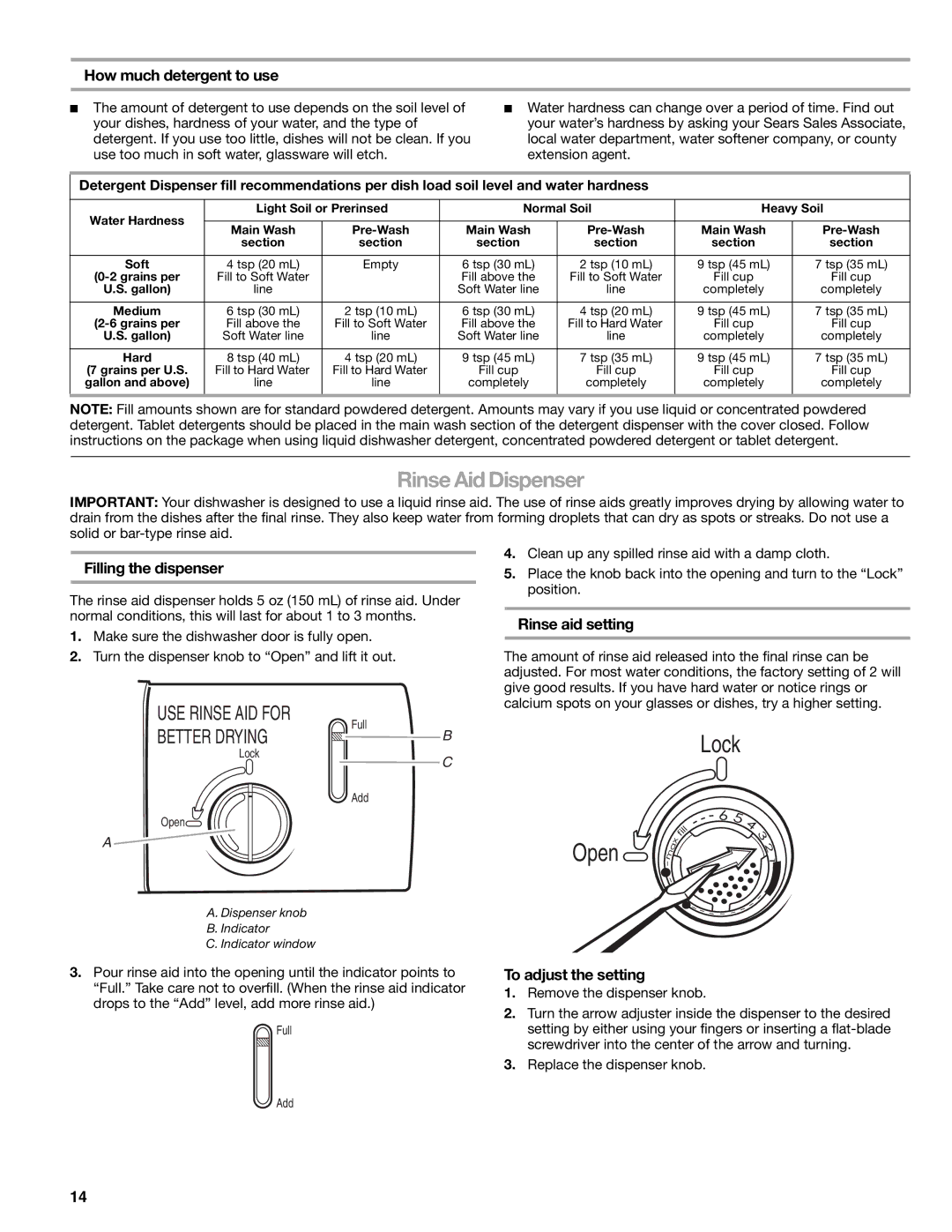
How much detergent to use
■The amount of detergent to use depends on the soil level of your dishes, hardness of your water, and the type of detergent. If you use too little, dishes will not be clean. If you use too much in soft water, glassware will etch.
■Water hardness can change over a period of time. Find out your water’s hardness by asking your Sears Sales Associate, local water department, water softener company, or county extension agent.
Detergent Dispenser fill recommendations per dish load soil level and water hardness
Water Hardness | Light Soil or Prerinsed | Normal Soil | Heavy Soil | ||||
|
|
|
|
|
| ||
Main Wash | Main Wash | Main Wash | |||||
| |||||||
| section | section | section | section | section | section | |
|
|
|
|
|
|
| |
Soft | 4 tsp (20 mL) | Empty | 6 tsp (30 mL) | 2 tsp (10 mL) | 9 tsp (45 mL) | 7 tsp (35 mL) | |
Fill to Soft Water |
| Fill above the | Fill to Soft Water | Fill cup | Fill cup | ||
U.S. gallon) | line |
| Soft Water line | line | completely | completely | |
|
|
|
|
|
|
| |
Medium | 6 tsp (30 mL) | 2 tsp (10 mL) | 6 tsp (30 mL) | 4 tsp (20 mL) | 9 tsp (45 mL) | 7 tsp (35 mL) | |
Fill above the | Fill to Soft Water | Fill above the | Fill to Hard Water | Fill cup | Fill cup | ||
U.S. gallon) | Soft Water line | line | Soft Water line | line | completely | completely | |
|
|
|
|
|
|
| |
Hard | 8 tsp (40 mL) | 4 tsp (20 mL) | 9 tsp (45 mL) | 7 tsp (35 mL) | 9 tsp (45 mL) | 7 tsp (35 mL) | |
(7 grains per U.S. | Fill to Hard Water | Fill to Hard Water | Fill cup | Fill cup | Fill cup | Fill cup | |
gallon and above) | line | line | completely | completely | completely | completely | |
|
|
|
|
|
|
| |
NOTE: Fill amounts shown are for standard powdered detergent. Amounts may vary if you use liquid or concentrated powdered detergent. Tablet detergents should be placed in the main wash section of the detergent dispenser with the cover closed. Follow instructions on the package when using liquid dishwasher detergent, concentrated powdered detergent or tablet detergent.
Rinse Aid Dispenser
IMPORTANT: Your dishwasher is designed to use a liquid rinse aid. The use of rinse aids greatly improves drying by allowing water to drain from the dishes after the final rinse. They also keep water from forming droplets that can dry as spots or streaks. Do not use a solid or
4. Clean up any spilled rinse aid with a damp cloth.
Filling the dispenser
The rinse aid dispenser holds 5 oz (150 mL) of rinse aid. Under normal conditions, this will last for about 1 to 3 months.
1.Make sure the dishwasher door is fully open.
2.Turn the dispenser knob to “Open” and lift it out.
USE RINSE AID FOR
BETTER DRYING | Full |
B | |
Lock | C |
| |
| Add |
Open |
|
A
A. Dispenser knob
B.Indicator
C.Indicator window
3.Pour rinse aid into the opening until the indicator points to “Full.” Take care not to overfill. (When the rinse aid indicator drops to the “Add” level, add more rinse aid.)
Full
5.Place the knob back into the opening and turn to the “Lock” position.
Rinse aid setting
The amount of rinse aid released into the final rinse can be adjusted. For most water conditions, the factory setting of 2 will give good results. If you have hard water or notice rings or calcium spots on your glasses or dishes, try a higher setting.
| fill | Lock654 | ||
| 3 | |||
| max |
| ||
Open |
| 2 | ||
|
| |||
| - | 1 | ||
To adjust the setting
1.Remove the dispenser knob.
2.Turn the arrow adjuster inside the dispenser to the desired setting by either using your fingers or inserting a
3.Replace the dispenser knob.
Add
14
